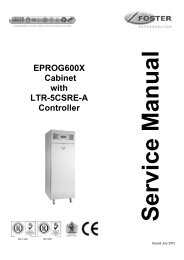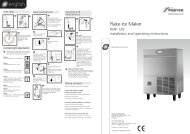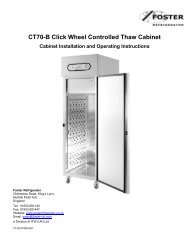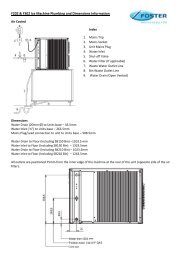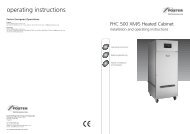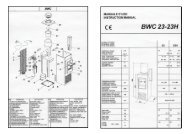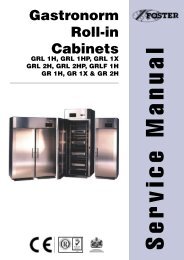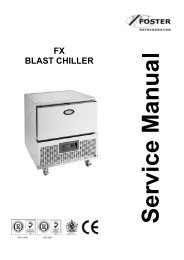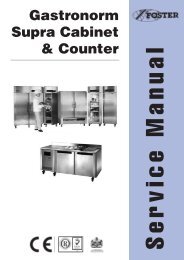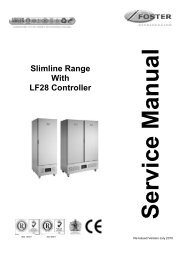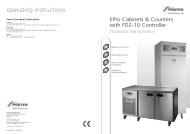Blast Chillers & Freezers - Foster Spares & Service
Blast Chillers & Freezers - Foster Spares & Service
Blast Chillers & Freezers - Foster Spares & Service
Create successful ePaper yourself
Turn your PDF publications into a flip-book with our unique Google optimized e-Paper software.
GB<br />
The air temperature is controlled between -20°C and +2°C in two phases. Firstly it will be reduce to -20°C<br />
for the first 80% of the cycle or until the product probe has been lowered significantly. This will extract the maximum<br />
amount of heat quickly from the product.<br />
The air temperature is then increased to +1°C for the final section of the cycle. This time reduces surface damage<br />
and will ensure quality levels.<br />
Hard Max Chill<br />
The ‘Hard Max’ cycle is used to reduce the product temperature to around +3°C. The air temperature in this<br />
incidence is maintained at -20°C for the whole cycle. After either a pre-determined time or the product temperature<br />
has been achieved the air temperature is allowed to rise into the ‘hold’ value where the temperature is maintained<br />
until the cycle is stopped.<br />
The average cycle time is 90 minutes but actual chill time is dependent on the product type or load. ‘Hard Max’ is<br />
normally used with packaged or specialist products<br />
Freeze<br />
By ‘Shock Freezing’ you change the state of the food into a frozen product and this enables a long term storage<br />
facility. To achieve this the cycle rapidly reduces the product temperature until a uniform -18°C is achieved. To<br />
enable this, the air temperature is maintained at around -35°C. This cycle normally runs for around 240 minutes;<br />
however the actual duration is dependent upon several factors:<br />
Product type<br />
Load<br />
Quantity<br />
How (if applicable) portions are organised<br />
The initial product temperature<br />
The type of storage container used<br />
Long Term Storage or Hold Mode (Conservation)<br />
When a chill cycle has completed; either by time lapsed or temperature of product, the controller will automatically<br />
enter a ‘hold’ mode. The display will show the ‘End’ screen and the EOC (End of Cycle) alarm will sound. After this<br />
there are three possible options available:<br />
> Press and hold the ‘Stop’ Button.<br />
As soon as the stop button has been pressed & held the EOC alarm will silence. While holding the button<br />
the display will show the stopping screen. If the button is not held until all three progression blocks have<br />
filled red then the ‘End’ screen will not display. If held correctly the filled blocks will disappear and the cycle<br />
will terminate, in turn displaying the ‘Home’ screen.<br />
> Press and Release the ‘Mute’ button.<br />
If you press the ‘Mute’ button the EOC alarm will silence and the display will show an active ‘Hold’ screen.<br />
This screen will have a green border and progress blocks which will fill at a rate of one per second.<br />
The display will also show the competed hold time and the total cycle time at the top centre of the<br />
screen. The controller will maintain the hold mode indefinitely; allowing defrosts (although the EOC alarm<br />
will not sound again) until the stop button is pressed and held (as described above).<br />
> Do nothing.<br />
In this case the EOC will sound for a length of time (determined by the parameter EOC Max. Time) until<br />
going automatically into a ‘Hold’ screen. This ‘Hold’ screen will be as described above but with no alarm<br />
sounding and instead of a green boarder will show in red. Again the progress blocks will fill one per second<br />
but again in red.<br />
This hold cycle will continue indefinitely; allowing defrosts, but the EOC will sound periodically as<br />
determined by the parameter ‘EOC Rpt. Int’ until the ‘Stop’ button is pressed and held (initiating the first<br />
instance described – the stopping screen).<br />
During the hold mode the cycle parameter will determine the temperature, but generally the air temperature<br />
will be held at +2°C following a chill cycle and -21°C following a freeze.<br />
4



